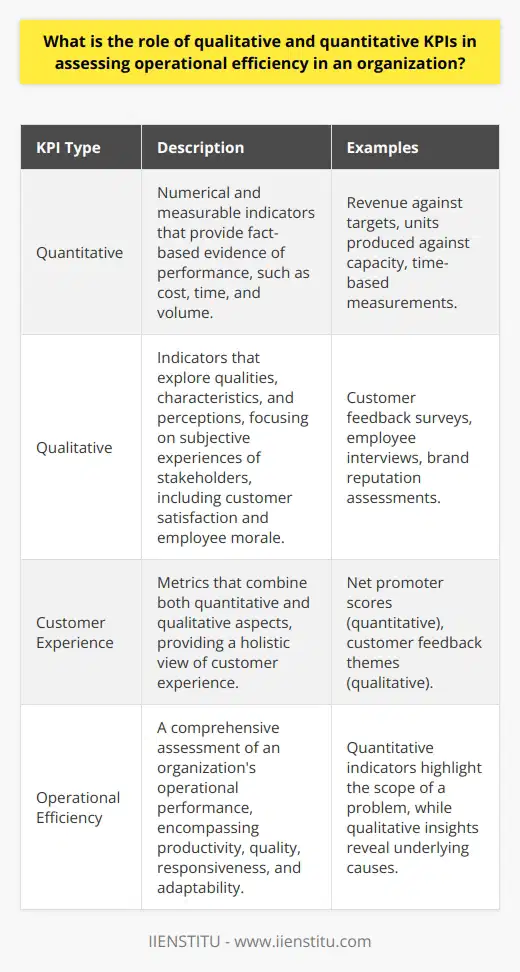
In an ever-evolving business landscape, the measurement and analysis of performance are paramount. It is not merely sufficient to have objectives and strategies in place; understanding whether the tactics employed are yielding the desired results is where the true essence of business success lies.
This is precisely where Key Performance Indicators (KPIs) come into the picture. As tools that quantifiably measure effectiveness, KPIs offer an invaluable means for an organization to track progress towards its strategic goals. By focusing on the data that truly matters, businesses can streamline their operations, enhance productivity, and ultimately establish a clear path towards sustainable growth.
Introduction to Key Performance Indicators (KPIs)
Definition and overview of KPIs
At their core, KPIs serve as the navigational instruments for businesses, guiding them through the unforgiving seas of the market towards their intended destinations. They are a set of quantifiable measures that help organizations evaluate success in relation to preset goals. A well-structured logistics course fees might cover KPIs in-depth, detailing how they can be systematically applied across different dimensions of supply chain management, from warehousing and transportation to inventory and delivery performance.
The importance of KPIs in business and management
Understanding and implementing KPIs is not merely a managerial preference; it’s a necessity for any business intent on success. They drive efficiency by pinpointing precisely where improvements are needed and where resources should be concentrated. Without them, organizations are prone to the perils of misdirection and resource wastage. In a world where competition is rife, the ability to adapt and optimize based on performance feedback is what separates the leaders from the followers.
Purpose and utility of KPIs in organizations
The quintessential utility of KPIs lies in their dual purpose: the foresight they provide and their capacity to trigger retrospective analyses. By establishing clear metrics, organizations can anticipate trends and adjust accordingly. Moreover, by dissecting previous performance data, they can draw insights that are vital for shaping future strategy. A comprehensive understanding of KPIs is often included in online courses with certificates, offering professionals an edge when it comes to strategic business management.
Types of Key Performance Indicators
Quantitative indicators
Explanation and examples of quantitative KPIs
Quantitative KPIs are numerical and hence offer an objective basis for measurement. They can be directly associated with numbers such as revenue, profit margins, and customer acquisition rates. A business, for instance, could set a quantitative KPI to increase production yield by 15% by the end of the quarter, offering a clear target for the production team.
Qualitative indicators
Explanation and examples of qualitative KPIs
While harder to measure, qualitative KPIs are equally vital. They encapsulate the quality of processes or roles, gauging aspects such as customer satisfaction, employee engagement, and brand strength. A company may rely on customer feedback scores as a qualitative KPI to assess and improve service levels. Though subjective, these indicators provide depth and context to the more cut-and-dry figures furnished by quantitative KPIs.
Leading indicators
Definition and examples of leading KPIs
Leading KPIs are proactive, predictive, and offer foresight into the future performance of a business. They can signal upcoming changes in the market or consumer behavior that might affect the company's performance. A leading KPI could be the number of new leads in a sales pipeline, which indicates potential future sales.
Lagging indicators
Explanation and examples of lagging KPIs
Contrary to leading indicators, lagging indicators reflect outcomes following certain actions or periods. They are reflective and historical, such as total sales in a quarter or customer churn over the past year. Although they cannot predict future success, they are essential for benchmarking.
Input indicators
Overview and examples of input KPIs
Input indicators measure the amount of resources put into a process. These can take the form of hours worked by employees, materials used in production, or money spent on marketing. By controlling inputs, companies can seek efficiencies that improve the bottom line.
Process indicators
Explanation and examples of process KPIs
Process indicators track the efficacy of the processes that transform inputs into outputs. They enable businesses to assess operational performance, like the cycle time of a manufacturing process or the average resolution time of customer support tickets.
Output indicators
Definition and examples of output KPIs
Output indicators measure the results - what is produced by the business. Typical examples include the number of units produced, customer cases resolved, or products developed. They are critical in evaluating the direct yield of business operations.
The Design and Selection of KPIs
The process and steps involved in KPI design
Designing a KPI is a delicate process that incorporates steps such as defining goals, identifying key business processes, determining data sources, and designing a framework for measurement. The success of KPI deployment starts here, as without a robust design, KPIs may not truly represent the performance they are meant to index.
Factors to consider when selecting appropriate KPIs
Selecting the right KPIs is crucial and contingent upon factors like relevance to strategic goals, data availability, and alignment with business operations. There must be a synergistic relationship between KPI selection and the organizational vision for them to drive meaningful action.
The role of organizational objectives in shaping KPIs
Every KPI must resonate with the broader objectives of the organization. They need to be shaped and contoured to fit the unique strategy, culture, and operational cadence of the business. KPIs that are divorced from these elements will, at best, provide a skewed picture of performance or, at worst, guide the organization astray.
Importance of aligning KPIs with organization's strategy
Alignment of KPIs with the organization's strategy is the linchpin in ensuring that daily activities are purpose-driven and are steering the organization towards its strategic milestones. Without such alignment, KPIs lose their strategic efficacy and become mere numbers without a narrative.
Implementing and Managing KPIs
Role of management in implementing KPIs
Management carries the torch when it comes to KPI implementation. Leadership must endorse the KPI culture, ensuring it permeates throughout the organization. It's their role to communicate the purpose of KPIs, train employees in their usage, and lead by example.
Monitoring and tracking KPIs
Constant monitoring and tracking of KPIs are required to ensure the organization remains on course. This involves setting up the necessary infrastructure for data collection and analysis, which allows for real-time tracking of performance against targets.
Adapting and updating KPIs
As a business evolves, so must its KPIs. They need to be periodically reviewed and updated to reflect new goals, market conditions, or changes in business direction. This dynamism ensures that KPIs stay relevant and useful as decision-making tools.
The role of technology in managing KPIs
Technology is crucial in managing KPIs efficiently. With the plethora of data generated across various business functions, modern businesses often rely on technology such as business intelligence tools to gather, process, and visualize KPIs, making it easier for stakeholders to interpret and act upon them.
Case Studies: Effective Use of KPIs
Examples of companies effectively using KPIs
Learning from successful examples is invaluable. Looking at companies like Amazon, which meticulously tracks KPIs to perfect their logistics operations, offers key insights into the significance and impact of effective KPI management. They employ a variety of KPIs, from delivery times to quality metrics, effectively steering the company roadmap.
Lessons drawn from their successful KPI implementation
The lesson drawn from such companies is clear: the effective use of KPIs is not just about selection and measurement but integrating them into the company's DNA. These businesses instill a culture of performance and improvement where KPIs serve as a guiding light for all decisions.
Critical evaluation of their KPI management strategies
However, one must critically assess that not all strategies will suit every business model. Tailoring KPIs to reflect the unique challenges and opportunities of a particular organization is essential to extract the maximum benefit from these powerful tools.
Pitfalls and Challenges in KPI Management
Common mistakes in determining and using KPIs
It's common to see businesses fall into the trap of tracking vanity metrics that don't translate to actionable insight, or simply establish too many KPIs, leading to analysis paralysis. Another common mistake is failing to communicate the relevance and purpose of KPIs to the team, thereby rendering them irrelevant.
Overcoming challenges in KPI implementation
To overcome these hurdles, it is essential to maintain a focused set of KPIs, ensure team members understand their significance, and provide training where necessary. Moreover, creating a culture that values data-driven decision-making is key in surmounting these challenges.
Importance of flexible and adaptive approach in KPI management
Flexibility and adaptability in KPI management are crucial. Organizations must be willing to reassess their KPIs in the face of new evidence or changing market conditions. An adaptive approach allows for the refinement of strategies and assurances that KPIs continue to be aligned with business objectives.
Brief summary of the blog content
This article has ventured into the realm of KPIs, exploring their definition, types, design, implementation, and management, peppered with examples and case studies. We've unearthed not only their critical importance in driving business success but also how they should be tailored, monitored, and adapted to ensure relevancy.
Reinforcement of the importance and role of KPIs
Ultimately, the establishment and management of KPIs is an ongoing quest for relevance and precision. These indicators are the pulse of any organization, manifesting the efficiency, effectiveness, and overall health of the business.
Encouragement for effective KPI consideration and use in business management.
Businesses that master the art of KPI management are well on their way to securing a competitive edge. It is an encouraging call to action for organizations to earnestly embrace KPIs, to turn data into information, information into insight, and insight into strategic foresight.
Frequently Asked Questions
What are the crucial Key Performance Indicators (KPIs) that influence the overall success of a business?
Understanding Key Performance Indicators
Key Performance Indicators, or KPIs, measure a company's success. These metrics vary. Industry and business goals affect them. They give vital insights. Managers must monitor them closely.
Financial Performance
Revenue Growth signifies sales increases. It reflects market demand.
Profit Margins reveal cost efficiency. Higher margins suggest better cost control.
Return on Investment (ROI) shows profitability. It compares gains to costs.
Liquidity Ratios determine cash flow health. They include Current and Quick ratios.
Earnings Before Interest and Taxes (EBIT) measures operational success. It excludes finance and tax factors.
Customer Metrics
Customer Lifetime Value (CLV) projects future earnings. It considers customer relationships.
Customer Acquisition Cost (CAC) calculates marketing efficiency. Lower CAC means cheaper customer growth.
Net Promoter Score (NPS) gauges customer satisfaction. High NPS indicates loyal customers.
Churn Rate tracks customer retention. Low churn means better loyalty.
Operational Efficiency
Inventory Turnover assesses stock management. Frequent turnover shows operational agility.
Employee Productivity mirrors workforce efficiency. It measures output per worker.
Strategic Performance
Market Share indicates competitive position. More share equals greater industry influence.
Brand Equity measures brand value. High equity builds customer trust.
Innovation and Development
Research and Development (R&D) Spend reflects innovation commitment. More spend suggests future growth.
Patents Filed demonstrates inventive activity. Patents protect and monetize innovations.
Conclusion
No single KPI dictates success. Businesses need a balanced approach. They must align KPIs with goals. Regular assessment is crucial. Adjust strategies as needed. Effective KPI management ensures long-term success.

How can analytical frameworks assist in evaluating the effectiveness of KPIs in business success?
Analytical Frameworks and KPI Effectiveness
Business success often hinges on effective performance measurement. Key Performance Indicators (KPIs) serve as critical gauges for such measurement. Yet, assessing the true impact of KPIs challenges many businesses. Here, analytical frameworks play an invaluable role. They streamline evaluation processes. They clarify how KPIs align with business goals.
Understanding Analytical Frameworks
Analytical frameworks consist of methods and tools. They guide systematic data examination. Such frameworks support decision-making. They enable deeper insights into business performance.
The Role of KPIs in Business Success
KPIs measure strategic and operational achievements. They provide feedback on progress. They highlight areas needing improvement. Without them, businesses struggle to quantify success. Yet, not all KPIs possess clarity and relevance.
Evaluating KPI Effectiveness
Analytical frameworks facilitate rigorous KPI evaluation. They reveal how well KPIs reflect strategic objectives. Three steps guide this evaluation:
- Define KPI purposes.
- Gather and analyze relevant data.
- Assess alignment with business strategies.
Frameworks help businesses avoid common pitfalls. These include selecting irrelevant KPIs. They prevent misinterpretation of data as well.
Frameworks Enhance Strategic Alignment
Frameworks encourage selecting KPIs that match business goals. They ensure that KPIs drive the intended outcomes. Businesses can then focus on metrics that matter. They can ignore those that do not.
Making Use of Benchmarking
Benchmarking is a key component of analytical frameworks. It involves comparing KPIs with industry standards. It highlights performance relative to peers. This comparison sharpens organizational focus. It galvanizes improvement efforts.
Data Analysis Techniques Improve Understanding
Frameworks include various data analysis techniques. These techniques uncover trends and patterns in KPI performance. They provide context. This context makes KPIs more meaningful. It helps to inform better decision-making.
Continuous Improvement Through Feedback Loops
Analytical frameworks often incorporate feedback loops. These loops enable continuous KPI refinement. They help businesses adapt. Adaptation is critical in evolving markets.
Examples of Analytical Frameworks
Several analytical frameworks support KPI evaluation:
- SWOT Analysis targets internal and external factors.
- Balanced Scorecard aligns KPIs with strategic vision.
- SMART Criteria guide the setting of effective KPIs.
Each framework offers a structured approach. These approaches aim to improve business performance. They ensure KPIs truly reflect business success.
Conclusion
In short, analytical frameworks are essential. They guarantee that KPIs serve their intended purpose. With these tools, businesses can reliably measure and pursue success. They can refine their strategies. They can adapt to change. They drive sustained performance. Analytical frameworks make KPIs more than mere numbers. They transform them into powerful tools for strategic insight and competitive advantage.

What is the role of qualitative and quantitative KPIs in assessing operational efficiency in an organization?
Understanding KPIs in Operational Efficiency
Operational efficiency sits at the crux of organizational success. It represents the prowess with which an entity utilizes its resources to achieve its objectives. Two distinct types of Key Performance Indicators, or KPIs, guide this assessment: qualitative and quantitative.
The Quantitative KPI Angle
Quantitative KPIs are numerical. They offer measurable evidence of performance. Through metrics such as cost, time, and volume, these indicators render a fact-based view of operations.
Consider time-based measurements. They precisely track efficiency. Answers to "How fast?" or "How many?" lie here. Such clarity aids in benchmarking. It fosters objective decision-making. Diving into sales, for instance, quantitative KPIs measure actual revenue against targets. Likewise, in production, they gauge units produced against the set capacity.
Numbers bring simplicity to complexity. They track progress toward goals. With them, leaders compare current performance to past data. This comparison fosters data-driven strategies. It encourages a culture of continuous improvement. This reliance on hard data underpins objective evaluation. It anchors performance management in reality.
The Qualitative KPI Lens
Qualitative KPIs demand a nuanced approach. They hinge on qualities, characteristics, and perceptions. These indicators explore how stakeholders perceive services or products. They delve into customer satisfaction and employee morale. Such insights surpass what numbers can convey. They embody the subjective experiences of people involved.
Gather customer feedback. Assess it. Herein lies the strength of qualitative KPIs. Surveys and interviews become key tools. They tap into customer loyalty and brand reputation. Assessing team dynamics also falls here. It weighs on productivity and innovation. Qualitative KPIs thus influence strategic decision-making. They balance the starkness of numbers with human elements.
Bridging Quantitative and Qualitative KPIs
An organization thrives when it balances both KPI types. Quantitative indicators offer a solid performance framework. Qualitative indicators complement this with rich, context-specific insights. One without the other gives an incomplete picture. Together, they forge a holistic view.
Managers gauge not just the outcome, but also the process. They explore not solely the 'what' but also the 'how'. Customer experience metrics, for instance, straddle both realms. They quantify aspects like net promoter scores. They qualify themes from customer feedback.
Efficiency goes beyond mere productivity. It encompasses quality, responsiveness, and adaptability. These facets demand a diverse metrics portfolio. Quantitative KPIs might highlight a problem's scope. Qualitative KPIs often reveal the underlying causes. Together, they guide targeted improvements. They align operations with strategic goals.
Teams need to understand both KPI types. They require training to interpret and utilize them effectively. Only then can an organization ensure a comprehensive evaluation of its operations. The interplay of both qualitative and quantitative metrics informs a robust operational strategy.
In sum, the role of qualitative and quantitative KPIs is pivotal. They offer a dual lens to scrutinize and enhance operational efficiency. They empower organizations to excel in service delivery and innovation. They ensure that an entity not only survives but thrives in a competitive landscape.



